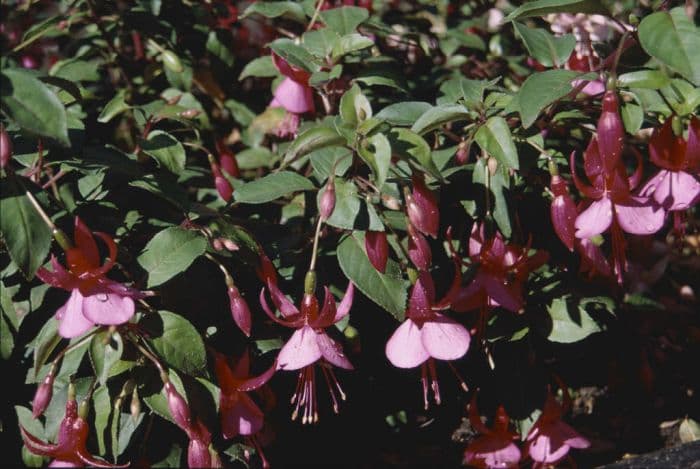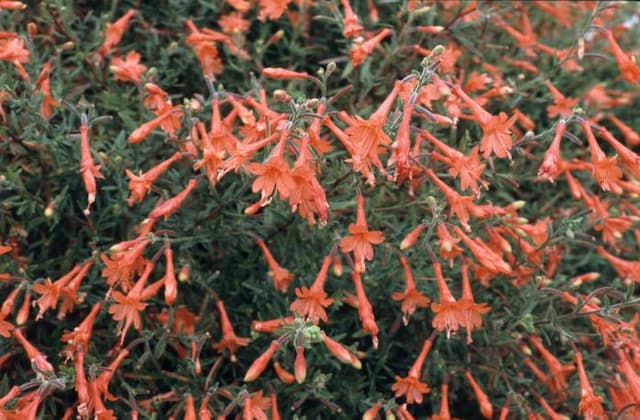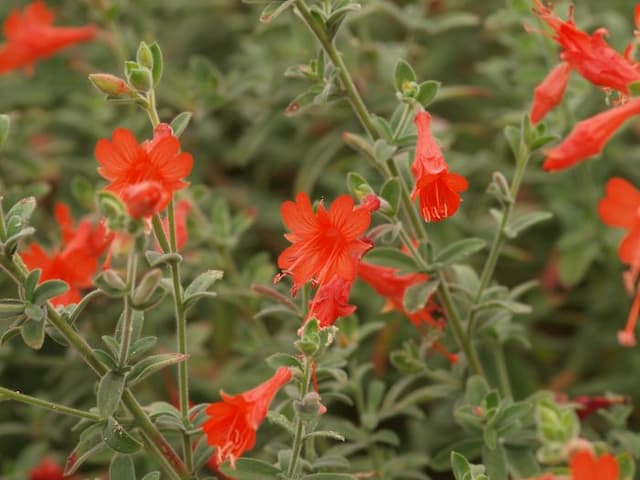Fuchsia Fuchsia 'Display'

ABOUT
The Fuchsia 'Display' is a vibrant and ornamental plant known for its striking and pendulous tear-drop-shaped flowers. The blooms are a spectacular combination of two colors, often with a deep purple or pink outer layer called the tube and sepals, and an inner layer that consists of a softer, usually violet or white, ruffled skirt known as the corolla. These eye-catching flowers dangle gracefully from the plant's branches like delicate earrings, creating a dramatic display that can be quite captivating. The foliage of the Fuchsia 'Display' is a lush green, consisting of small to medium-sized leaves that are oval or elliptical in shape. The leaves have a slight serration along their edges that provides a touch of texture, complementing the soft and flowing nature of the flowers. The veins on the leaves are mildly prominent, giving them a distinguished contour that adds to the overall aesthetic of the plant. Branches on the Fuchsia 'Display' are slender and often bend slightly under the weight of the flowers, giving the plant an elegant, arching appearance. This contributes to the plant's cascading effect, which is particularly beautiful when the plant is positioned in hanging baskets or elevated containers. The stems are normally green but may show some woody characteristics as the plant matures. The fuchsia's color combination, along with its unique flower shape, makes it a popular choice for gardeners who want to add a touch of drama and exotic flair to their landscapes or home gardens. It is equally admired by hummingbirds and butterflies that are attracted to its vivid colors and sweet nectar.
About this plant
 Names
NamesFamily
Onagraceae
Synonyms
Ladies’ Eardrops, Fuchsia
Common names
Fuchsia 'Display'.
 Toxicity
ToxicityTo humans
The Fuchsia plant, commonly referred to simply as Fuchsia, is not considered toxic to humans. Generally, ingestion of the berries or other parts of the plant doesn't cause serious harm. However, it may cause mild gastrointestinal discomfort, such as nausea or diarrhea, in certain individuals, especially if consumed in large quantities. It's always wise to exercise caution and avoid eating plants not explicitly grown for consumption.
To pets
The Fuchsia plant is not known to be toxic to pets either. It is generally considered safe around both cats and dogs. Much like in humans, the consumption of parts of the plant by pets can potentially cause mild digestive upset, but it is not expected to cause serious illness or be life-threatening. Even so, to prevent any potential discomfort for your pet, it's best to keep an eye on them and discourage them from munching on ornamental plants.
 Characteristics
CharacteristicsLife cycle
Perennials
Foliage type
Deciduous
Color of leaves
Green
Flower color
Mixed
Height
2 feet (0.61 meters)
Spread
2 feet (0.61 meters)
Plant type
Shrub
Hardiness zones
9
Native area
Central and South America
Benefits
 General Benefits
General Benefits- Ornamental Appeal: Features striking two-toned flowers that add visual interest and aesthetic value to gardens and living spaces.
- Hummingbird Attractant: The vibrant flowers attract hummingbirds, which can help pollinate other plants in the garden.
- Container Gardening: Suitable for pots and hanging baskets, allowing for versatile placement and gardening in limited spaces.
- Long Flowering Season: Offers a long blooming period from spring to fall, providing consistent color and beauty.
- Shade Tolerance: Thrives in partial shade, making it ideal for brightening up darker areas of the garden.
- Easy Propagation: Can be easily propagated from cuttings, allowing gardeners to create more plants for free.
 Medical Properties
Medical PropertiesThis plant is not used for medical purposes.
 Air-purifying Qualities
Air-purifying QualitiesThis plant is not specifically known for air purifying qualities.
 Other Uses
Other Uses- Fabric Dye: The blossoms of the Fuchsia can be used to create a light purple or pink dye for fabric, lending a natural color to textiles.
- Ink Making: Similar to fabric dyeing, the juice from Fuchsia flowers can be used to make natural inks for writing or artistic purposes.
- Culinary Garnish: Edible varieties of Fuchsia flowers can be used as decorative garnishes for salads or desserts, adding elegance and color.
- Cooking Oil: Fuchsia seeds, if available in large quantities, could be pressed to extract oil for use in cooking, although this is not a common practice.
- Photography: Fuchsias, with their vivid colors and unique shapes, are excellent subjects for botanical photography to capture the essence of a garden or natural space.
- Study in Botany Education: Fuchsia plants, with their specific growing needs and characteristics, can be used for educational purposes in botany and horticulture classes.
- Symbolic Gifts: Fuchsias are sometimes used in floral arrangements or given as potted plants to symbolize confiding love in the language of flowers.
- Floral Art: Their vivid colors and pendulous blooms make Fuchsias suitable for use in floral art and competitive flower arranging.
- Crafting: Dried Fuchsia flowers can be used in crafting, such as in the creation of potpourri or for embedding in decorative candles.
- Personal Care Products: The essence of Fuchsia flowers can be infused into lotions or bath oils for fragrance, though this is a niche use.
Interesting Facts
 Feng Shui
Feng ShuiThe Fuchsia is not used in Feng Shui practice.
 Zodiac Sign Compitability
Zodiac Sign CompitabilityThe Fuchsia is not used in astrology practice.
 Plant Symbolism
Plant Symbolism- Confiding Love: The delicate, hanging blooms of the Fuchsia plant signify a deep trust and confiding love between individuals.
- Elegance and Grace: Fuchsia's elegant drooping flowers are seen as a symbol of high sophistication and graceful beauty.
- Good Taste: The vibrant and unique flowers represent a quality of good taste in matters of art and cultural appreciation.
- Ardent Love: The rich colors and the long-lasting nature of the flowers reflect a passionate and devoted love.
 Water
WaterFuchsia 'Display', commonly known as a Fuchsia, requires consistent moisture without being waterlogged. It is ideal to water the plant when the top inch of the soil feels dry to the touch. Generally, this means watering approximately once or twice a week, but this can vary depending on temperature and humidity levels. Use room temperature water and gently pour it around the base of the plant until water begins to drain from the bottom of the pot, indicating thorough saturation. For an average-sized Fuchsia, this may equate to around 16 to 24 ounces of water for each watering session, though the exact amount will depend on the size of your plant and its growing conditions.
 Light
LightFuchsias, including the Fuchsia 'Display', thrive in bright, indirect light. They perform best when protected from the harsh midday sun, so a spot with morning sun or dappled sunlight is ideal. Indoors, a window that receives filtered light or a position that gets some direct morning or late afternoon sun would be suitable. Avoid placing your Fuchsia in full shade or full sun, as this can either lead to poor flowering or scorching of leaves.
 Temperature
TemperatureThe Fuchsia 'Display' prefers cooler temperatures, ideally between 55 and 75 degrees Fahrenheit. They can tolerate a minimum of around 40 degrees, but should be protected from frost. These plants do not fare well in extreme heat, and temperatures consistently above 76 degrees can lead to stress and wilting. Keep your Fuchsia in a climate-controlled environment during the hottest parts of the day, especially during summer.
 Pruning
PruningPruning your Fuchsia 'Display' promotes bushier growth and increases flower production. Prune in late winter or early spring before new growth begins. Remove any dead or damaged branches to maintain the health of the plant, and pinch back the tips of the stems to encourage branching. Pruning can be done every few months or as needed to shape the plant and remove any sparse, leggy growth. The best time for a significant prune is when the plant is not actively flowering.
 Cleaning
CleaningAs needed
 Soil
SoilFuchsia 'Display', commonly known as Fuchsia, thrives best in a soil mix that is well-draining, rich in organic matter, and maintains moisture without becoming waterlogged. A mix of two parts peat moss or coco coir to one part perlite or vermiculite is often recommended. The ideal pH range for Fuchsia is slightly acidic to neutral, around 6.0 to 7.0.
 Repotting
RepottingFuchsia plants, commonly referred to as Fuchsias, should generally be repotted annually, especially when they are young and growing vigorously. For mature plants, repotting every two to three years is sufficient unless they become root-bound or the soil appears to be depleted.
 Humidity & Misting
Humidity & MistingFuchsia plants, commonly known as Fuchsia, prefer high humidity levels, ideally between 60% to 70%. However, they can tolerate humidity levels down to about 50% with proper care.
 Suitable locations
Suitable locationsIndoor
For Fuchsias, provide bright indirect light, keep soil moist, and ensure high humidity.
Outdoor
Place Fuchsias in dappled shade, protect from harsh sun, and shelter from strong winds.
Hardiness zone
7-10 USDA
 Life cycle
Life cycleThe life cycle of Fuchsia 'Display' begins with seed germination, where warmth, light, and moisture trigger the growth of the seed into a small seedling. As the seedling grows, it develops roots and shoots, which will form the adult plant's structure. In its vegetative stage, the plant produces stems and leaves, increasing in size and creating the framework for future flowering. The next stage is flowering, where Fuchsia 'Display' produces its distinctive hanging, tubular flowers in vibrant colors, typically during the spring and summer months. After pollination, which is often aided by hummingbirds or insects attracted to the flowers, the plant sets fruit in the form of small berries that contain seeds, completing its reproductive cycle. During the fall and winter, the plant may enter a period of dormancy, particularly in cooler climates, dropping leaves and reducing growth until conditions become favorable in spring again.
 Propogation
PropogationPropogation time
Spring-Early Summer
Fuchsia 'Display', commonly known as Fuchsia, is most popularly propagated through softwood cuttings, which is a method that sees the most success in the late spring or early summer. To propagate by cuttings, a gardener would select a healthy piece of new growth approximately 2 to 4 inches long, making sure there are a few sets of leaves. The cutting should be snipped just below a leaf joint or node, and the lower leaves must be removed. It's beneficial to dip the cut end into rooting hormone powder to encourage root growth, then insert the cutting into a pot filled with a mixture of peat and perlite. The cutting should be kept moist but not overly wet and placed in indirect sunlight. After a few weeks, once roots have established, the new Fuchsia plant can be transferred to a more permanent pot or garden location.









